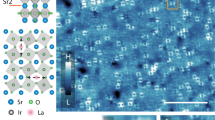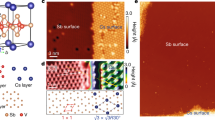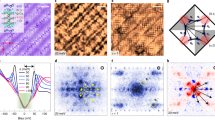Abstract
Layered perovskite iridates realize a rare class of Mott insulators that are predicted to be strongly spin–orbit coupled analogues of the parent state of cuprate high-temperature superconductors1,2. Recent discoveries of pseudogap3,4,5, magnetic multipolar ordered6 and possible d-wave superconducting phases7,8 in doped Sr2IrO4 have reinforced this analogy among the single layer variants. However, unlike the bilayer cuprates9, no electronic instabilities have been reported in the doped bilayer iridate Sr3Ir2O7. Here we show that Sr3Ir2O7 realizes a weak Mott state with no cuprate analogue9 by using ultrafast time-resolved optical reflectivity to uncover an intimate connection between its insulating gap and antiferromagnetism. However, we detect a subtle charge density wave-like Fermi surface instability in metallic electron doped Sr3Ir2O7 at temperatures (TDW) close to 200 K via the coherent oscillations of its collective modes, which is reminiscent of that observed in cuprates10,11. The absence of any signatures of a new spatial periodicity below TDW from diffraction12, scanning tunnelling12 and photoemission13,14 based probes suggests an unconventional and possibly short-ranged nature of this density wave order.
This is a preview of subscription content, access via your institution
Access options
Access Nature and 54 other Nature Portfolio journals
Get Nature+, our best-value online-access subscription
$29.99 / 30 days
cancel any time
Subscribe to this journal
Receive 12 print issues and online access
$259.00 per year
only $21.58 per issue
Buy this article
- Purchase on Springer Link
- Instant access to full article PDF
Prices may be subject to local taxes which are calculated during checkout




Similar content being viewed by others
References
Kim, B. J. et al. Novel Jeff = 1/2 Mott state induced by relativistic spin–orbit coupling in Sr2IrO4 . Phys. Rev. Lett. 101, 076402 (2008).
Wang, F. & Senthil, T. Twisted Hubbard model for Sr2IrO4: magnetism and possible high temperature superconductivity. Phys. Rev. Lett. 106, 136402 (2011).
Kim, Y. K. et al. Fermi arcs in a doped pseudospin-1/2 Heisenberg antiferromagnet. Science 345, 187–190 (2014).
de la Torre, A. et al. Collapse of the Mott gap and emergence of a nodal liquid in lightly doped Sr2IrO4 . Phys. Rev. Lett. 115, 176402 (2015).
Cao, Y. et al. Hallmarks of the Mott-metal crossover in the hole-doped pseudospin-1/2 Mott insulator Sr2IrO4 . Nat. Commun. 7, 11367 (2016).
Zhao, L. et al. Evidence of an odd-parity hidden order in a spin–orbit coupled correlated iridate. Nat. Phys. 12, 32–36 (2016).
Kim, Y. K., Sung, N. H., Denlinger, J. D. & Kim, B. J. Observation of a d-wave gap in electron-doped Sr2IrO4 . Nat. Phys. 12, 37–41 (2016).
Yan, Y. J. et al. Electron-doped Sr2IrO4: an analogue of hole-doped cuprate superconductors demonstrated by scanning tunneling microscopy. Phys. Rev. X 5, 41018 (2015).
Lee, P. A., Nagaosa, N. & Wen, X.-G. Doping a Mott insulator: physics of high-temperature superconductivity. Rev. Mod. Phys. 78, 17–85 (2006).
Torchinsky, D. H., Mahmood, F., Bollinger, A. T., Božović, I. & Gedik, N. Fluctuating charge-density waves in a cuprate superconductor. Nat. Mater. 12, 387–391 (2013).
Hinton, J. P. et al. New collective mode in YBa2Cu3O6+x observed by time-domain reflectometry. Phys. Rev. B 88, 060508 (2013).
Hogan, T. et al. First-order melting of a weak spin–orbit Mott insulator into a correlated metal. Phys. Rev. Lett. 114, 257203 (2015).
de la Torre, A. et al. Coherent quasiparticles with a small Fermi surface in lightly doped Sr3Ir2O7 . Phys. Rev. Lett. 113, 256402 (2014).
He, J. et al. Spectroscopic evidence for negative electronic compressibility in a quasi-three-dimensional spin–orbit correlated metal. Nat. Mater. 14, 577–582 (2015).
Park, H. J. et al. Phonon-assisted optical excitation in the narrow bandgap Mott insulator Sr3Ir2O7 . Phys. Rev. B 89, 155115 (2014).
Okada, Y. et al. Imaging the evolution of metallic states in a correlated iridate. Nat. Mater. 12, 707–713 (2013).
Wang, Q. et al. Dimensionality-controlled Mott transition and correlation effects in single-layer and bilayer perovskite iridates. Phys. Rev. B 87, 245109 (2013).
Fujiyama, S. et al. Weak antiferromagnetism of Jeff = 1/2 band in bilayer iridate Sr3Ir2O7 . Phys. Rev. B 86, 174414 (2012).
King, P. D. C. et al. Spectroscopic indications of polaronic behavior of the strong spin–orbit insulator Sr3Ir2O7 . Phys. Rev. B 87, 241106 (2013).
Kim, J. et al. Large spin-wave energy gap in the bilayer iridate Sr3Ir2O7: evidence for enhanced dipolar interactions near the Mott metal-insulator transition. Phys. Rev. Lett. 109, 157402 (2012).
Moretti Sala, M. et al. Evidence of quantum dimer excitations in Sr3Ir2O7 . Phys. Rev. B 92, 024405 (2015).
Chia, E. E. M. et al. Quasiparticle relaxation across the spin-density-wave gap in the itinerant antiferromagnet UNiGa5 . Phys. Rev. B 74, 140409 (2006).
Torchinsky, D. H., Chen, G. F., Luo, J. L., Wang, N. L. & Gedik, N. Band-dependent quasiparticle dynamics in single crystals of the Ba0.6K0.4Fe2As2 superconductor revealed by pump-probe spectroscopy. Phys. Rev. Lett. 105, 027005 (2010).
Rothwarf, A. & Taylor, B. N. Measurement of recombination lifetimes in superconductors. Phys. Rev. Lett. 19, 27–30 (1967).
Kabanov, V. V., Demsar, J., Podobnik, B. & Mihailovic, D. Quasiparticle relaxation dynamics in superconductors with different gap structures: theory and experiments on YBa2Cu3O7−δ . Phys. Rev. B 59, 1497–1506 (1999).
Li, L. et al. Tuning the Jeff = 1/2 insulating state via electron doping and pressure in the double-layered iridate Sr3Ir2O7 . Phys. Rev. B 87, 235127 (2013).
Wall, S. et al. Tracking the evolution of electronic and structural properties of VO2 during the ultrafast photoinduced insulator–metal transition. Phys. Rev. B 87, 115126 (2013).
Gretarsson, H. et al. Two-magnon Raman scattering and pseudospin-lattice interactions in Sr2IrO4 and Sr3Ir2O7 . Phys. Rev. Lett. 116, 136401 (2016).
Demsar, J., Biljaković, K. & Mihailovic, D. Single particle and collective excitations in the one-dimensional charge density wave solid K0.3MoO3 probed in real time by femtosecond spectroscopy. Phys. Rev. Lett. 83, 800–803 (1999).
Hogan, T. et al. Disordered dimer state in electron-doped Sr3Ir2O7 . Phys. Rev. B 94, 100401(R) (2016).
Acknowledgements
We thank V. Madhavan and Z. Wang for providing scanning tunnelling microscopy data and analysis on (Sr1−xLax)3Ir2O7 samples and for helpful discussions. This work is supported by a GIST-Caltech Collaboration Grant and by ARO Grant W911NF-13-1-0059. Instrumentation was partially supported by ARO DURIP Award W911NF-13-1-0293. D.H. acknowledges funding provided by the Institute for Quantum Information and Matter, an NSF Physics Frontiers Center (PHY-1125565) with support of the Gordon and Betty Moore Foundation through Grant GBMF1250. S.D.W. acknowledges support under NSF award No. DMR-1505549 as well as partial support from the MRSEC Program of the National Science Foundation under Award No. DMR 1121053 (T.H.).
Author information
Authors and Affiliations
Contributions
H.C., L.Z. and D.H. planned the experiment. H.C. performed the measurements. H.C., A.d.l.T., D.H. and L.Z. analysed the data. T.H. and S.D.W. prepared and characterized the samples and performed RIXS measurements. H.C. and D.H. wrote the manuscript.
Corresponding author
Ethics declarations
Competing interests
The authors declare no competing financial interests.
Supplementary information
Supplementary Information
Supplementary Information (PDF 421 kb)
Rights and permissions
About this article
Cite this article
Chu, H., Zhao, L., de la Torre, A. et al. A charge density wave-like instability in a doped spin–orbit-assisted weak Mott insulator. Nature Mater 16, 200–203 (2017). https://doi.org/10.1038/nmat4836
Received:
Accepted:
Published:
Issue Date:
DOI: https://doi.org/10.1038/nmat4836
This article is cited by
-
Fano interference between collective modes in cuprate high-Tc superconductors
Nature Communications (2023)
-
Electronic nature of the pseudogap in electron-doped Sr2IrO4
npj Quantum Materials (2022)
-
Effects of the on-site energy on the electronic response of Sr3(Ir1−xMnx)2O7
Scientific Reports (2022)
-
Doping and temperature evolutions of optical response of Sr3(Ir1-xRux)2O7
Scientific Reports (2020)
-
Phase-resolved Higgs response in superconducting cuprates
Nature Communications (2020)



